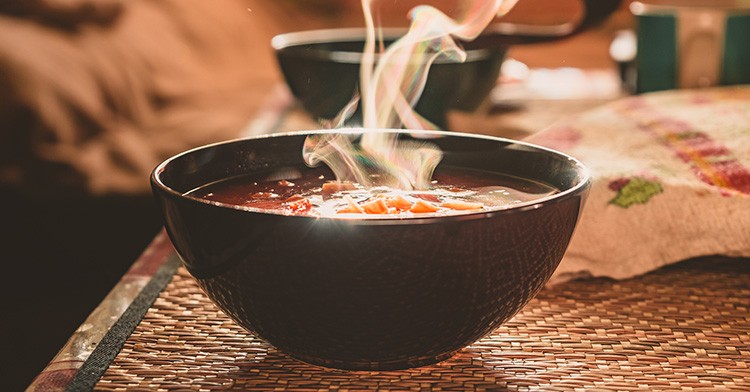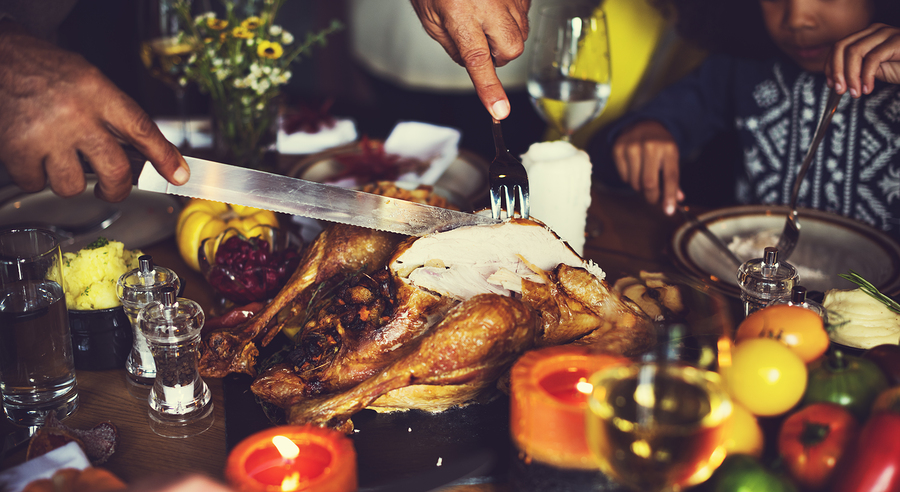As a chill inhabits the air each autumn, nightfall arrives earlier, ushered in by the sound of crickets, toads and bullfrogs in my backyard. The holidays, a time for merriment, approach. Visits with co-workers, children, relatives and friends, as well as homecoming and football games, begin to dot my calendar. Thanksgiving and its temptations beckon.
Colder temperatures stimulate a craving for warmth of the spirit, hearth and palate. Grocery stores are stocked with orange and yellow fall vegetables. Pumpkins for the pot and the front porch. My culinary interest, however, is the pumpkin’s cousin, acorn squash. I am contemplating soup, and this squash is its heart and soul.
My acorn squash soup will be a dainty addition to my Caribbean American family’s Thanksgiving menu. But this soup is distinctly American. It is my new take on an old favorite.
I grew up in Montserrat, a lush volcanic Caribbean island with a strong agricultural tradition. Soup was the Saturday meal of my boyhood; we called it Saturday soup. The dish includes local ingredients: sweet potatoes, white potatoes, carrots, pumpkin, red beans and pigeon peas or black-eyed peas, breadfruit if in season, pig tails, chicken back and neck, smoked turkey neck or beef.
Soup is even more associated with Caribbean cuisine than peas and rice, curried goat, or stewed oxtails. In “Food Culture in the Caribbean,” Lynn Marie Houston writes that hot soups are one-dish meals enjoyed throughout the islands, with strong ties to our history of enslavement and peasantry. They’re popular for Saturday meals because that’s the only day folks have the time to cook three-hour dishes.
Cattle were slaughtered on Friday nights — I saw the butcher walking behind his steer on the way to the slaughterhouse each Friday afternoon — and by Saturday, the meat was bubbling in pots on kerosene stoves across our tiny island.
We bought fresh vegetables at the Plymouth Market on Saturdays. While my Grandmother Peggy shopped, I sold sweet buns and homemade ginger beer to the peddlers who came from the lush east of the island to sell produce. Around noon, we walked home with bags filled with fresh produce and beef from the butcher’s stall.
Later that day, my grandmother stood over the concrete sink. Her left hand deftly wielded a knife as she skinned the green bananas and peeled the carrots, potatoes, chayote squash and dasheens (also known as taro root). As the soup boiled, she mixed flour and cornmeal to make saucer-shaped dumplings. The mixture filled the pot to the brim.
The heat and the aroma of the boiling stew filled our zinc-roofed kitchen. The upper half of the Dutch back door hung open. The cacophony of barking dogs and the cackle of hens and roosters were the soundtrack to that lazy, easy time of the week.
Once her soup was ready, I sat shirtless at the kitchen table, bent over an enamel bowl, spoon in hand. I always went for the sweet potato first, then the dasheen, dumplings and peas, while avoiding the chayote squash. Sweat covered my forehead and streamed down my back. The sea breeze blowing through the window did nothing to cool down the kitchen, or me.
My version of soup is both a celebration of my past and a rejection of it. The soup I make is not my grandmother’s soup. Mine reflects the faster pace, the hustle and bustle of my American lifestyle. My soup can be ready in less than an hour, start to finish — it’s done before I can listen to all my favorite versions of “Goodness of God” on YouTube.
Hers was a communal meal, shared immediately with our family, elderly shut-in neighbors and unexpected but welcome visitors to our house. Rarely were there leftovers.
By contrast, my cooking is what people call meal prep, planning ahead. I cook soup for the leaner days when my refrigerator is empty and my longing for a simple meal runs deep.
At another level, it also reflects the socioeconomic difference between me and the people who raised me. Almost everything they did was about survival, meeting and satisfying the needs of the day, the present. Thanks to their sacrifice, I have been given the luxury of more choice (and more appliances). I can plan for tomorrow and the day after that, even weeks into the future. My Grandmother Peggy rarely had the option of warming frozen soup from her modest fridge.
Rather than the heavy meal of the day, my soup is sustenance for weekday evenings after work. It is a light meal, soup as supper rather than dinner. It is heavy enough to satisfy yet light enough to digest after my 30-minute evening walk and weightlifting workout.
It’s also a soup that breaks the rules and traditions I was raised in, practices still maintained by many Caribbean immigrants each Saturday all year long.
For example, I grew up eating pumpkin. But my college friend Bridgette Lacy always spoke about roasted acorn squash and its soup potential, so I tried it. The acorn squash, with its colorful green, orange and yellow skins, proved perfect for soup when peeled and diced. I add a whole onion and two or three sauteed bell peppers. Eight cups of water or chicken broth. Vegetables and seasonings. I then toss in some rotisserie chicken.
I usually cook soup late in the afternoon, or even at night. I have the kitchen and living room to myself. I turn on my Bluetooth speaker. Instead of the sound of hens and roosters cackling while I cook, my playlist is a hit parade of the 70s and early 80s: Lou Rawls, Earth Wind & Fire, David Ruffin and Teddy Pendergrass. Their words of yearning and longing are the poetry of an island boy’s first love.
Other nights, the choruses of “La Boheme” influence my mood as parsley, chives and oregano season my soup. The aroma of red onions, bell peppers and herbs saturates the air. That is my fill for the moment. The soup is for later, this week, this month. Even as the pot boils, I wash the dishes, sweep the floor, wipe the countertops. A spotless kitchen is as important to my wife as a cup of tasty soup is to me.
The acorn squash lends a sweet taste and full body to my soup without the burden of too many calories. That makes it a perfect addition to my Caribbean American relatives’ Thanksgiving meal. Alongside the rice and peas, the oxtails, the fried red snapper and baked sweet potatoes — everything that reminds them of home — my American soup is an earthy appetizer. It stimulates the palate and the senses without filling the stomach. This soup can hold them over until the ham and turkey are baked and the tardy in-laws have arrived for dinner.
This soup binds hearts and spirits. In a culinary sense, it’s a constant — new yet timeless, a different recipe but the same result. Sustenance for the body and soul. A present craving for the joys of the past. Sip by sip, spoonful by spoonful, it takes me home again.
Alongside the rice and peas, the oxtails, the fried red snapper and baked sweet potatoes — everything that reminds them of home — my American soup is an earthy appetizer.
















